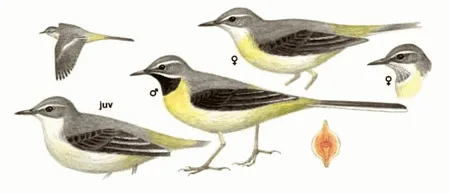
Grey Wagtail
[order] PASSERIFORMES | [family] Motacillidae | [latin] Motacilla cinerea | [UK] Grey Wagtail | [FR] Bergeronnette des ruisseaux | [DE] Gebirgsstelze | [ES] Lavandera Cascadena | [NL] Grote Gele Kwikstaart
Subspecies
| Genus | Species | subspecies | Breeding Range | Breeding Range 2 | Non Breeding Range |
| Motacilla | cinerea | EU | widespread | OR, AF | |
| Motacilla | cinerea | canariensis | |||
| Motacilla | cinerea | cinerea | |||
| Motacilla | cinerea | melanope | |||
| Motacilla | cinerea | patriciae | |||
| Motacilla | cinerea | robusta | |||
| Motacilla | cinerea | schmitzi |
Physical charateristics
Longer and more attenuated than any other west Palearctic wagtail, with slimness of rear body enhanced by exccptionally long tail.
Very graceful, lithe, slim wagtail, with almost constantly grey above and yellow below. Wings largely black and tail black with white outer feathers. Male has black bib in summer.
Flight action exceptionally bounding. sexes dissimilar, seasonal variation marked in male.
Very graceful, lithe, slim wagtail, with almost constantly grey above and yellow below. Wings largely black and tail black with white outer feathers. Male has black bib in summer.
Flight action exceptionally bounding. sexes dissimilar, seasonal variation marked in male.
Listen to the sound of Grey Wagtail
[audio:http://www.aviflevoland.nl/sounddb/G/Grey Wagtail.mp3]
Copyright remark: Most sounds derived from xeno-canto
| wingspan min.: | 25 | cm | wingspan max.: | 27 | cm |
| size min.: | 18 | cm | size max.: | 20 | cm |
| incubation min.: | 11 | days | incubation max.: | 14 | days |
| fledging min.: | 13 | days | fledging max.: | 14 | days |
| broods: | 2 | eggs min.: | 4 | ||
| eggs max.: | 7 |
Range
Eurasia : widespread
Habitat
In west Palearctic, occurs mainly in temperate middle and lower-middle latitudes, overlapping sparingly into boreal and Mediterranean. Typical breeding habitats include combination of 1) Fresh water, especially fast-running streams and rivers, but also canals, lowland streams, and margins of lakes, both oligotrophic and eutrophic. 2) Rock slabs, boulders, vertical rock faces, shingle or gravel stream beds, or artefacts. 3) Sheltering trees, shrubs, or dense herbage. 4)Holes, ledges, or hollows for nesting.
Reproduction
Nest site in hole or crevice in wall or bank, and among tree roots, sometimes under bridge. Nest cup of grass, roots and small twigs, often with moss, lined hair. Build by both sexes.
4-6 eggs, sub-elliptical, smooth and glossy, whitish, cream or grey-buff, faintly marked grey or grey-buff. Incubation by both sexes.
4-6 eggs, sub-elliptical, smooth and glossy, whitish, cream or grey-buff, faintly marked grey or grey-buff. Incubation by both sexes.
Feeding habits
Diet based on insects. Two main foraging techniques:
1) Bird walks or runs, repeatedly picking up small items or chasing more mobile prey, with tail wagging and snapping up, down, or to one side,apparently to flush insects, may also wade in shallow water picking up tadpoles or lunging for small fish.
2) Flies from perch or ground, in addition, may hover to obtain flying insects or prey from leaves or tree crevices.
1) Bird walks or runs, repeatedly picking up small items or chasing more mobile prey, with tail wagging and snapping up, down, or to one side,apparently to flush insects, may also wade in shallow water picking up tadpoles or lunging for small fish.
2) Flies from perch or ground, in addition, may hover to obtain flying insects or prey from leaves or tree crevices.
Conservation
This species has an extremely large range, and hence does not approach the thresholds for Vulnerable under the range size criterion (Extent of Occurrence <20,000 km2 combined with a declining or fluctuating range size, habitat extent/quality, or population size and a small number of locations or severe fragmentation). The population trend appears to be stable, and hence the species does not approach the thresholds for Vulnerable under the population trend criterion (>30% decline over ten years or three generations). The population size is extremely large, and hence does not approach the thresholds for Vulnerable under the population size criterion (<10,000 mature individuals with a continuing decline estimated to be >10% in ten years or three generations, or with a specified population structure). For these reasons the species is evaluated as Least Concern.
Motacilla cinerea has a discontinuous breeding distribution in western and southern
Europe, the Caucasus and the western Urals, with Europe accounting for less than a
quarter of its global breeding range. Its European breeding population is large
(>740,000 pairs), and was stable between 1970-1990. The species remained stable
overall during 1990-2000, with the vast majority of national populations stable or
increasing?including the key one in Romania.

Migration
Mainly a partial migrant, but wholly migratory or resident in some parts of range. Found in winter throughout most of European breeding range but some move to Africa as far south as southern Malawi. Winter range also includes Middle East, and birds from central and eastern Asia move to India and south-east Asia as far as New Guinea, with single record from northern Australia. Populations of Azores, Madeira, and Canary Islands are resident.
In autumn, movements within Europe of over 200 km mainly between north-west, south-west, and south-east in central and western Europe, and mainly around south-west in Britain. Coastal autumn passage occurs in Britain and Ireland, most marked at southern headlands and inshore islands and almost synchronous throughout, peaking mid-September. Northward passage in spring generally inconspicuous.
In autumn, movements within Europe of over 200 km mainly between north-west, south-west, and south-east in central and western Europe, and mainly around south-west in Britain. Coastal autumn passage occurs in Britain and Ireland, most marked at southern headlands and inshore islands and almost synchronous throughout, peaking mid-September. Northward passage in spring generally inconspicuous.
Distribution map

